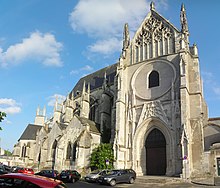St-Aignan (Orléans)
The Saint-Aignan Collegiate Church in Orléans is the remainder of the abbey of the same name. It is located in the Bourgogne district on the north bank of the Loire . It was consecrated to St. Bishop Aignan of Orléans († around 453).
It is not known when the monastery was founded. By the 7th century, it had developed into an abbey under the Benedictine Rule and the Rule of Columban of Luxeuil . At that time the abbey was owned by the Attigny domain in the Ardennes; between 642 and 651 King Clovis II acquired the domain from the abbot of the monastery of Saint-Aignan, who received the much closer Fleury, which was shortly afterwards renamed Saint-Benoît-sur-Loire than the monastery founded here with relics of Saint Benedict of Nursia was endowed.
In the 9th century, the monks assumed the status of canons . Partly with the help of Bishop Theodulf von Orléans , an advisor to Charlemagne , the community achieved complete autonomy, and its collegiate chapter became the second most important in the city after the chapter of the Orléans Cathedral . The most important lay abbots of this time were Hugo Abbas († 886), Hugo the Great († 956) and his son Hugo Capet († 996).
Also in the 9th century, the abbey suffered from raids by the Normans , especially in 865. In the town fire of 999, Saint-Aignan was also destroyed. All that remained of the monastery church was the crypt in which the relics of St. Aignan are kept. In 1029, after twelve years of construction, a new church was consecrated in the Romanesque style . During the siege of Orléans by the English in 1359, Saint-Aignan was demolished by the city's population (as were the churches of Saint-Pierre Ensentelée (now Saint-Pierre du Martroi) and Saint-Euverte to prevent the English from entering) used it as a jump ). Rebuilt in 1420, the suburban churches were demolished again in 1428, when the English were besieged again, on the orders of Bailli Raoul de Goncourt. Another new building was built from 1439. Later, King Ludwig XI. indicated that Saint-Aignan should be included in the expanded city fortifications. The Louis XI. financed rebuilding of the church was consecrated in 1509.
In 1562, during the Huguenot Wars , Saint-Aignan was sacked, in 1563 some of Aignan's relics were thrown on a stake (some bones were saved by a chorister - Jehan Minereau -), the church was partly burned down. In 1567 other parts were demolished. With the Peace of 1570, work began to make the church usable again: a wall was built between the nave and transept because the nave was too badly damaged, but Saint-Aignan had lost some of its importance due to the half-loss of his relics. 1619 was by Louis XIII. the restoration of the altarpiece that exists today is paid for.
In November 1790, during the French Revolution, the pen chapter disappeared; From 1792 to 1802 the church was first used for the production of military tents, then as a center for a revolutionary group, and from 1798 as the "Temple de la Reconnaisance et de la Victoire". From 1802, after the Concordat between Napoleon and the Pope, masses were held here again. However, Saint-Aignan was now just a simple parish church.
Today only the choir with four arches, the ambulatory, the transept and the crypt remain of the church. The nave, which was destroyed in the Wars of Religion, was demolished in 1804, as was the previously undamaged church tower in the west.
The crypt has been listed as a monument historique since 1840, and the entire church since 1910.
literature
- Denis Lottin: Recherches historiques sur la ville d'Orléans . A. Jacob / J.-B. Niel, Orléans, 1836-1845, Volume II, pp. 278-279.
- René Biémont: La collégiale de Saint-Aignan d'Orléans . Herluison, Orléans, 1876, p. 22.
- Marlène Britta, François Turellier, Philippe Vendrix: La vie musicale à Orléans de la fin de la guerre de Cent Ans à la Saint-Barthélemy . In: Marie-Luce Demonet-Launay, David Rivaud, Philippe Vendrix (eds.): Orléans, une ville de la Renaissance . Ville d'Orléans, Orléans / Center d'études supérieures de la Renaissance de Tours (CESR) Tours, Université François-Rabelais (Tours), 2009, ISBN 978-2-910173-34-0 , pp. 120-131.
Web links
- Crypte St Aignan . Orléans Métropole, February 13, 2018 (French).
- Eglise de Saint Aignan, Orléans. Tout le Loiret, archived from the original on June 12, 2011 ; accessed on February 13, 2018 (French).
- Eglise Saint-Aignan: Historique . Lieux de culte du Groupement paroissial Coeur de Ville d'Orléans, April 23, 2004 (French).
Coordinates: 47 ° 53 ′ 56.6 " N , 1 ° 54 ′ 54.9" E

